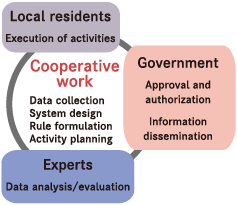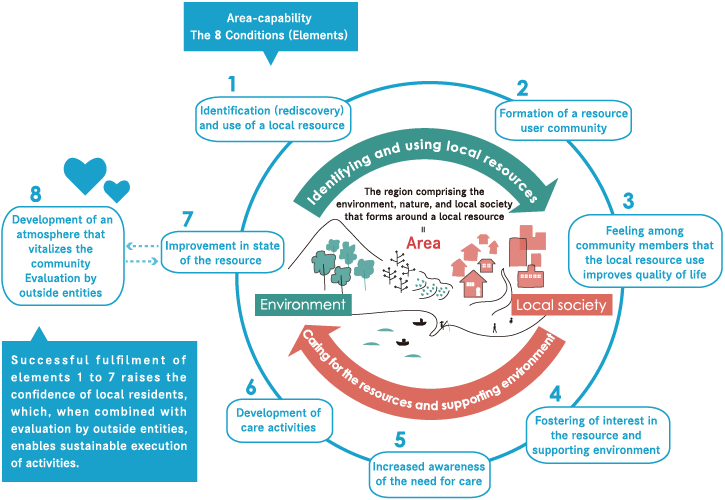What’s Area-capability?
Our project investigates the characteristics of the ecosystem of each region and the sustainable use of ecosystem services by local residents. It seeks to model the schemes that maintain the balance between use and conservation to produce a good practice model. “Area Capability (AC)” consists of the set of conditions necessary for expanding the use of ecosystem services.
The Concept of AC
AC is the capability for a region to become substantially richer through the active and responsible improvement of environmental wealth by people and utilizing the resources of the environment. We believe that in a local society, local people are to responsibly and sustainably build the future. Regions that cannot do this are facing complex economic and environmental challenges. AC can be said to be the necessary elements (conditions) for creating a beneficial relationship between local society and the environment so the region can experience sustainable development.
To advance regional development (vitalization) in accordance with the AC concept, eight conditions (elements) are necessary. We introduce these conditions and three major points here.
8 Conditions (Elements)
Area-capability The 8 Components(Elements)
- Identification (rediscovery) and use of a local resource
- Foremation of a resource user community
- Feeling among community members that the local resource use improves quality of life
- Forestering of interest in the resouce and supporting environment
- Increased awareness of the need for care
- Development of care activities
- Improvement in state of the resouce
- Development of an atmosphere that vitalizes the community
Evoluation by outside entities
⇒Successful fulfilment of elements 1 to 7 raises the confidence of local residents, which, when, combined with evalution by outside entities, enables sustainable execution of activities.
3 Points
- ● Point 1
Identifying and using local resources
A local resource is a natural or cultural resource unique to a given region that can exist in harmony with the region’s natural environment and culture. Hot springs and sightseeing resources are easy-to-understand examples of local resources, but do not exist everywhere. Every region has local resources. In some cases, however, it may necessary change one’s way of thinking or point of view to identify them. What is important is that the resource is used in the local community. If local resource use lead to the formation of a new community of resource users rather than the accumulation of benefit to certain individuals or groups, it will contribute to the realization of sustainable, vital community.
- ● Point 2
Caring for local resources and the supporting environment
To be able to use a local resource in perpetuity (sustainably), it is necessary to think about and “watch over” the resource and the environment supporting the resource, rather than “managing” the resource. We refer to such consideration, observation, and treatment of the environment as “care.” To be able to carry out this “care,” each member of the user community must foster an interest in and understanding of the resource and supporting environment and develop a sense of stewardship that leads them work to improve the state of the resource through care.
- ● Point 3

Cooperation among local residents, experts, and government For a community (local residents) to be able to conduct activities sustainably, it is important that experts and governments work together with communities. Objective verification and evaluation by outside entities not only enables the creation of systems that are scientifically more reliable but can also increase the confidence and pride of community members.
※For more details about Area-capability, please download data in the following.。










